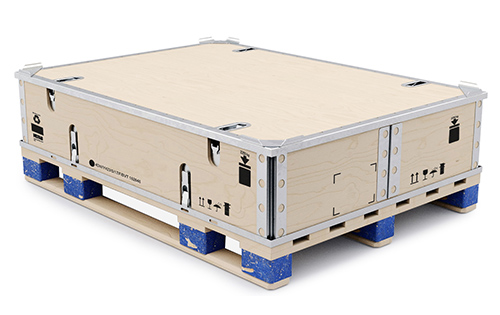Optimum Protection: Industrial Packaging Solutions Tailored for Success
Optimum Protection: Industrial Packaging Solutions Tailored for Success
Blog Article
Reliable Industrial Recycling Solutions for Sustainable Product Packaging: A Comprehensive Guide
That's where this extensive overview on effective commercial recycling remedies for lasting packaging comes in. By checking out essential areas such as product packaging material selection, making for recyclability, executing recycling framework, working together with reusing companions, and monitoring and gauging reusing success, this guide will certainly outfit you with the understanding and tools necessary to make enlightened choices and drive favorable modification within your organization. Whether you're a packaging professional, sustainability manager, or merely interested in the subject, this guide will certainly give important understandings and techniques to aid you browse the world of sustainable product packaging.
Product Packaging Product Choice
The selection of product packaging materials plays a crucial role in making certain the sustainability of commercial recycling options. The choice of materials is key in lessening ecological impact and making best use of reusing performance when it comes to lasting packaging. Picking the ideal products can help lower waste generation, save sources, and promote a circular economy.
Materials like cardboard, paper, glass, and specific types of plastics can be recycled numerous times without losing their top quality. On the other hand, products that are challenging to reuse, such as mixed plastics or non-recyclable compounds, can create obstacles for the recycling procedure and may finish up in incinerators or land fills.
Another factor to consider is making use of renewable and biodegradable materials. Product packaging made from renewable energies, such as plant-based plastics or biopolymers, can assist decrease reliance on nonrenewable fuel sources and reduce climate modification. In addition, biodegradable materials damage down normally over time, minimizing the buildup of waste in landfills.
Moreover, the weight and quantity of product packaging materials must be decreased to reduce transportation expenses and power intake. Lightweight materials not only need less sources throughout manufacturing but likewise add to decrease carbon exhausts throughout transport.
Designing for Recyclability
In order to make sure the recyclability of product packaging products, thoughtful design is necessary. Creating for recyclability entails creating packaging that can be easily sorted, separated, and refined in recycling centers. One important element of designing for recyclability is the choice of materials. Product packaging designers ought to focus on using products that are extensively approved for recycling and have established recycling infrastructures. Products such as glass, light weight aluminum, and particular kinds of plastic, like pet dog and HDPE, are generally reused and need to be favored over products that are challenging or costly to recycle.
An additional critical consideration in designing for recyclability is the removal of unneeded components or products. By reducing the variety of layers, finishes, and extra parts, product packaging can be made simpler and less complicated to recycle. In addition, designers should intend to reduce making use of mixed products, as they can make complex the recycling process.

Implementing Recycling Framework
Effective application of recycling framework is important for the success of commercial recycling remedies. Without appropriate framework in place, the reusing procedure becomes inefficient and ineffective, hindering the total goal of sustainable product packaging.
To execute reusing infrastructure properly, numerous key factors need to be considered. First of all, there should be a well-organized collection system that helps with the splitting up and collection of recyclable materials. This can consist of assigned recycling containers in public areas, along with partnerships with waste monitoring business for curbside pickup and sorting.
As soon as gathered, the recyclable materials need to be moved to recycling facilities in a prompt manner. This calls for effective logistics and transportation networks, making sure that the materials reach the ideal centers right away.
At the reusing facilities, progressed sorting and handling innovations ought to be in area to separate various types of materials efficiently. This includes the usage of automated arranging equipments, optical scanners, and manual sorting techniques.
Moreover, there should be a knockout post a durable market need for recycled products. This can be accomplished with partnerships with producers and industries that use recycled materials in their manufacturing procedures. Producing a stable market for recycled products incentivizes the reusing market and promotes the circular economy.
Teaming Up With Recycling Allies

One secret aspect of collaborating with reusing partners is the establishment of clear interaction channels. It is essential to establish open lines of interaction to promote the exchange of information, updates, and feedback. This permits both events to remain informed regarding the progress of reusing initiatives and deal with any type of challenges or concerns that might arise.
Furthermore, collaboration can involve joint initiatives in developing and applying recycling programs. Recycling companions can provide valuable understandings and guidance in developing effective collection systems and identifying one of the most appropriate recycling innovations. By interacting, organizations and recycling partners can maximize the recycling process and lessen waste.
Moreover, partnership can expand beyond the operational facets of reusing. It can likewise include campaigning for and education efforts. By signing up with pressures, businesses and recycling companions can elevate awareness regarding the relevance of recycling and promote the adoption of sustainable product packaging techniques among consumers and various other browse around this site stakeholders.
Monitoring and Measuring Recycling Success
To make certain the effectiveness of industrial recycling options and the success of lasting packaging goals, it is critical for businesses and their recycling partners to establish a thorough system for tracking and measuring recycling success (processing company). Tracking and gauging reusing success enables businesses to examine the influence of their reusing initiatives, recognize locations for renovation, and established significant targets for future progression
One method to track recycling success is through making use of data collection and analysis tools. By collecting information on the quantity of product packaging waste produced, the portion of waste that is recycled, and the types of products being reused, organizations can obtain beneficial understandings right into their recycling performance. This information can after that be examined to determine patterns, patterns, and areas of inefficiency.
An additional important facet of monitoring and gauging reusing success is establishing clear and standardized metrics. This enables companies to compare their performance versus industry standards and track their development in time. Metrics such as recycling prices, waste diversion rates, and greenhouse gas exhausts can supply a quantitative measure of a company's reusing success.

Verdict
In verdict, carrying out efficient industrial recycling solutions for sustainable packaging calls for cautious consideration of packaging product choice, making for recyclability, applying reusing infrastructure, working together with recycling partners, and tracking and measuring reusing success. By including these methods, businesses can add to a much more lasting and environmentally-friendly strategy to packaging, lowering waste and promoting the round economy.
By checking out key areas such as product packaging material choice, designing for recyclability, carrying out reusing facilities, teaming up with recycling companions, and monitoring and measuring reusing success, this overview will furnish you with the knowledge and tools needed to make informed choices and drive favorable change within your company. Packaging designers need to click over here now prioritize the usage of products that are widely approved for recycling and have developed reusing infrastructures.Partnership with reusing partners is essential for the effective execution of industrial reusing services and the accomplishment of lasting packaging objectives. By signing up with pressures, businesses and recycling partners can increase understanding concerning the importance of recycling and promote the adoption of sustainable product packaging techniques amongst consumers and various other stakeholders.
By accumulating data on the amount of product packaging waste generated, the percentage of waste that is recycled, and the kinds of products being reused, services can get useful understandings right into their recycling efficiency.
Report this page